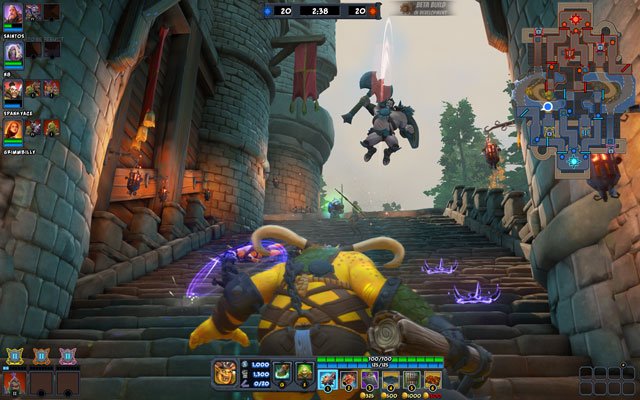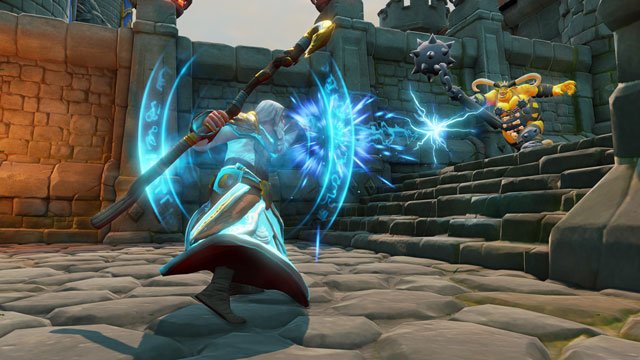Your orcs? Their orcs? They still must die.
After arriving in San Francisco to show off their new game, Orcs Must Die! Unchained, the development team from Robot Entertainment discovered that the computers that were supposed to be waiting for them had been accidentally replaced by a crate of generalissimo uniforms for Wargaming.net booth babes. Eventually, they were able to get their supplier on the horn and eight of the ten computers they needed arrived, so Robot Entertainment CEO Patrick Hudson made a call to a friend at Supergiant Games, who decided on-the-spot to loan them three of their development computers—with the source code for Transistor sitting on them—to run the demo off of. This kind of trust and companionship amongst indie developers warms the cockles of my heart and loosens my wallet. It was also loosened by free-to-play Orcs Must Die! Unchained being a helluva lot of fun to play.
The game is a multiplayer evolution of previous Orcs games, pitting two teams of warriors against each other in a combination of MOBA and tower defense/offense for which Robot Entertainment has coined the genre "Fortress Siege." We played three five-on-five matches, and each match began with the players setting traps and picking which minions would spew from the first of their upgradeable and unlockable bases. Depending on the character class you decided to play, you could choose to shepherd your minions towards the enemy's rift, or hang back defensively and pick off the minions and the heroes working with them.
As The Master, an elder mage with powerful ranged attacks, armor based on how full his mana guage is, but with virtually no health; I hung back next to a Guardian—a drone in a suit of armor ready to club any enemy that came near it—whose close proximity helped refuel my mana. Of course, this did little to help when a trio of enemy heroes swarmed the guardian and myself. I tried to use one of The Master's special abilities, Feign Death, during which his mana refueled and he fell like a corpse to the ground, invincible for fifteen seconds. After the fifteen seconds were up, I was quickly clubbed to death by the enemy horde and had to wait to spawn back at my team's rift.
While we played, the developers critiqued the map, the first they've released that has three lanes for minions to attack from. As I ran across a river that crossed the width of the map, one of them said, "We should put stairs there, so the player can get back up!"
Another opined, "The Master should be slower. He's an old man, he shouldn't be sprinting like that!"
"The Master is already too slow!" came the response.
"… yeah." Laughs all-around.
At one point while playing the stealth class, as a cat-girl assassin called Midnight, I sprang from invisibility to kill one of the enemy heroes, whose body fell face-first into the river.
"Look! It almost looks like it's floating. We should make the bodies float downstream and go over the falls!" came a suggestion. To calls of agreement and laughter, this was something everyone seemed to agree on.

The last of the three matches was intense, as first one side opened up all three of their bases, allowing for three groups of minions to swarm the enemy at once. Soon the other team had their three bases up as well, making the game even more frenetic and uncertain as to who would win right up until the very end, which is something Robot Entertainment has worked hard to include in the game.
"You know how in League of Legends, you can start a game and feel like you've lost five minutes into a match?" Designer Jerome K. Jones said about the design, "We wanted to avoid that, so it could always turn around; you don't know who's going to win."
Everything in the game that you play, from which minions you choose, to the heroes you can play, to traps and power-ups, are card-based. These aren't the metaphorical cards that many games use, but are handled exactly like physical CCGs, Jones told me. "We have digital print runs, [but] we don't know if we've printed enough right now."
The cards come in packs, purchasable with in-game or real currency and feature a mix of rare, strong, and common cards. Jones discussed how he had a program on his computer that allowed him to see the distribution of rare cards in play, versus those still in un-purchased decks from the digital print run, to make sure the system is balanced.

When I asked about balance in general, Ian Fischer, Design Director, told me that they started off with the baseline mechanics first, calling it the "The British Problem" going back to their days as developers on Age of Empires as Ensemble Studios, first making the baseline mechanics work for one player-controlled character or group (The British) before moving on to others.
"We started with just the War Mage. We would have games of five-on-five, just the War Mage, running around fighting each other, until we turned on the other pieces," he mentioned. "One of the things that keeps you honest about your game is [that] you don't cover up a bunch of problems with a bunch of stuff. If it's not fun in the baseline with just [the core mechanic], then it's not fun."
Orcs Must Die! Unchained is definitely fun. It combines MOBA and tower defense gameplay with quick game sessions (Fischer and Jones said they were aiming for 15-minute play sessions, citing Wargaming.net's World of Tanks as an influence on playtimes; perhaps this is why they were sent their booth babe uniforms?) and a focus on an "anything can happen" feel. You can register for the closed PC Beta on the Orcs Must Die! Unchained website. It is scheduled for release in the fall.







